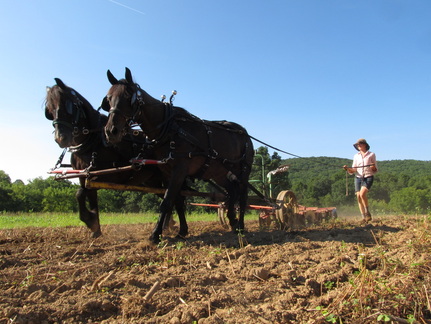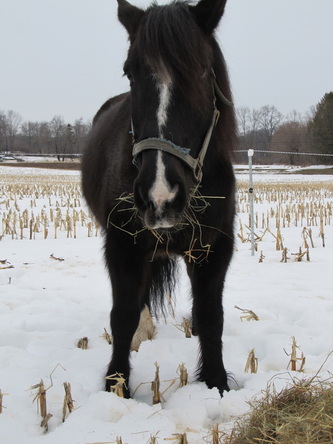Draft Horses

Horses contribute to our farm by supporting healthy soil life, providing fertility, and decreasing our dependence on foreign sources of energy—which bring fluctuating costs and hidden ecological and political burdens.
Through their balance of power, sensitivity, and grace, horses offer the farmer the opportunity to closely connect with the soil on which our livelihood depends. Because they are adept at performing a variety of tasks, horses fit well within a small, diversified farm. Horses are instrumental in enriching the soil, as they are a source of manure on the farm, thus creating rich farm-produced compost. In the fields, they tread lightly and do not contribute to soil compaction that can result from the weight of large machinery. Horses are essentially solar-powered; they run on grass and hay which they help us harvest from the farm. By using horses, we help to minimize our carbon footprint; they deliver living, clean, and sustainable energy.
The nature of work done with the horses, performed at a biological-pace, lends itself to a heightened sensitivity to the subtle qualities of the world around us—attuning us to the land and soils we work, and the plants we cultivate. Our intimate relationship with the horses challenges us to grow as human beings by keeping us alert and present in our work, preventing us from pushing ourselves or our land beyond our capacities, and depending on the dynamic human-equine relationship as the basis of our daily life.
Through their balance of power, sensitivity, and grace, horses offer the farmer the opportunity to closely connect with the soil on which our livelihood depends. Because they are adept at performing a variety of tasks, horses fit well within a small, diversified farm. Horses are instrumental in enriching the soil, as they are a source of manure on the farm, thus creating rich farm-produced compost. In the fields, they tread lightly and do not contribute to soil compaction that can result from the weight of large machinery. Horses are essentially solar-powered; they run on grass and hay which they help us harvest from the farm. By using horses, we help to minimize our carbon footprint; they deliver living, clean, and sustainable energy.
The nature of work done with the horses, performed at a biological-pace, lends itself to a heightened sensitivity to the subtle qualities of the world around us—attuning us to the land and soils we work, and the plants we cultivate. Our intimate relationship with the horses challenges us to grow as human beings by keeping us alert and present in our work, preventing us from pushing ourselves or our land beyond our capacities, and depending on the dynamic human-equine relationship as the basis of our daily life.

"And so we must suspect that horse-powered farms work well, not because-or not just because-horses are energy-efficient, but because they are living creatures, and therefore fit harmoniously into a pattern of relationships that are necessarily biological, and that rhyme analogically from ecosystem to crop, from field to farmer. In other words, ecosystem, farm, field, crop, horse, farmer, family, and community are in certain critical ways like each other. ...The health and fertility of each involves and is involved in the health and fertility of all."
Wendell Berry, People, Land, and Community, 1983
